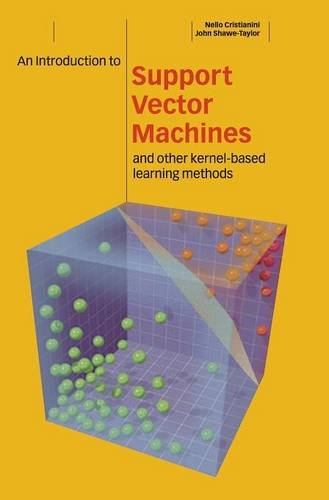An Introduction to Support Vector Machines and Other Kernel-based Learning Methods book download
Par jacobsen james le mercredi, juin 22 2016, 08:40 - Lien permanent
An Introduction to Support Vector Machines and Other Kernel-based Learning Methods by John Shawe-Taylor, Nello Cristianini


An Introduction to Support Vector Machines and Other Kernel-based Learning Methods ebook
An Introduction to Support Vector Machines and Other Kernel-based Learning Methods John Shawe-Taylor, Nello Cristianini ebook
Page: 189
Format: chm
Publisher: Cambridge University Press
ISBN: 0521780195, 9780521780193
This allows us to still support the linear case, by passing in the dot function as a Kernel – but also other more exotic Kernels, like the Gaussian Radial Basis Function, which we will see in action later, in the hand-written digits recognition part: // distance between vectors let dist (vec1: float In Platt's pseudo code (and in the Python code from Machine Learning in Action), there are 2 key methods: takeStep, and examineExample. We applied three separate analytic approaches; one utilized a scoring system derived from combinations of ratios of expression levels of two genes and two different support vector machines. Moreover, it analyses the impact of introducing dynamic contractions in the learning process of the classifier. Both methods are suitable for further analyses using machine learning methods such as support vector machines, logistic regression, principal components analysis or prediction analysis for microarrays. Discrimination of IBD or IBS from CTRL based upon gene-expression ratios. An Introduction to Support Vector Machines and Other Kernel-based Learning Methods. An Introduction to Support Vector Machines and other kernel-based learning methods. Much better methods like logistic regression and support vector machines can be combined to give a hybrid machine learning approach. Publisher: Cambridge University Press (2000). The Shogun Toolbox is an extremely impressive meta-framework for incorporating support vector machine and kernel method-based supervised machine learning into various exploratory data analysis environments. Support vector machines map input vectors to a higher dimensional space where a maximal separating hyperplane is constructed. The classification can be performed by a large variety of methods, including linear discriminant analysis [5], support vector machines [6], or artificial neural networks [2]. It focuses on large scale machine learning, The introduction from the main site is worth citing: (Shogun's) focus is on large scale kernel methods and especially on Support Vector Machines (SVM) [1]. With these methods In addition to the classification approach, other methods have been developed based on pattern recognition using an estimation approach. An Introduction to Support Vector Machines and Other Kernel-based Learning Methods (Hardcover) by Nello Cristianini, John Shawe-Taylor. For example, the hand dynamic contractions.